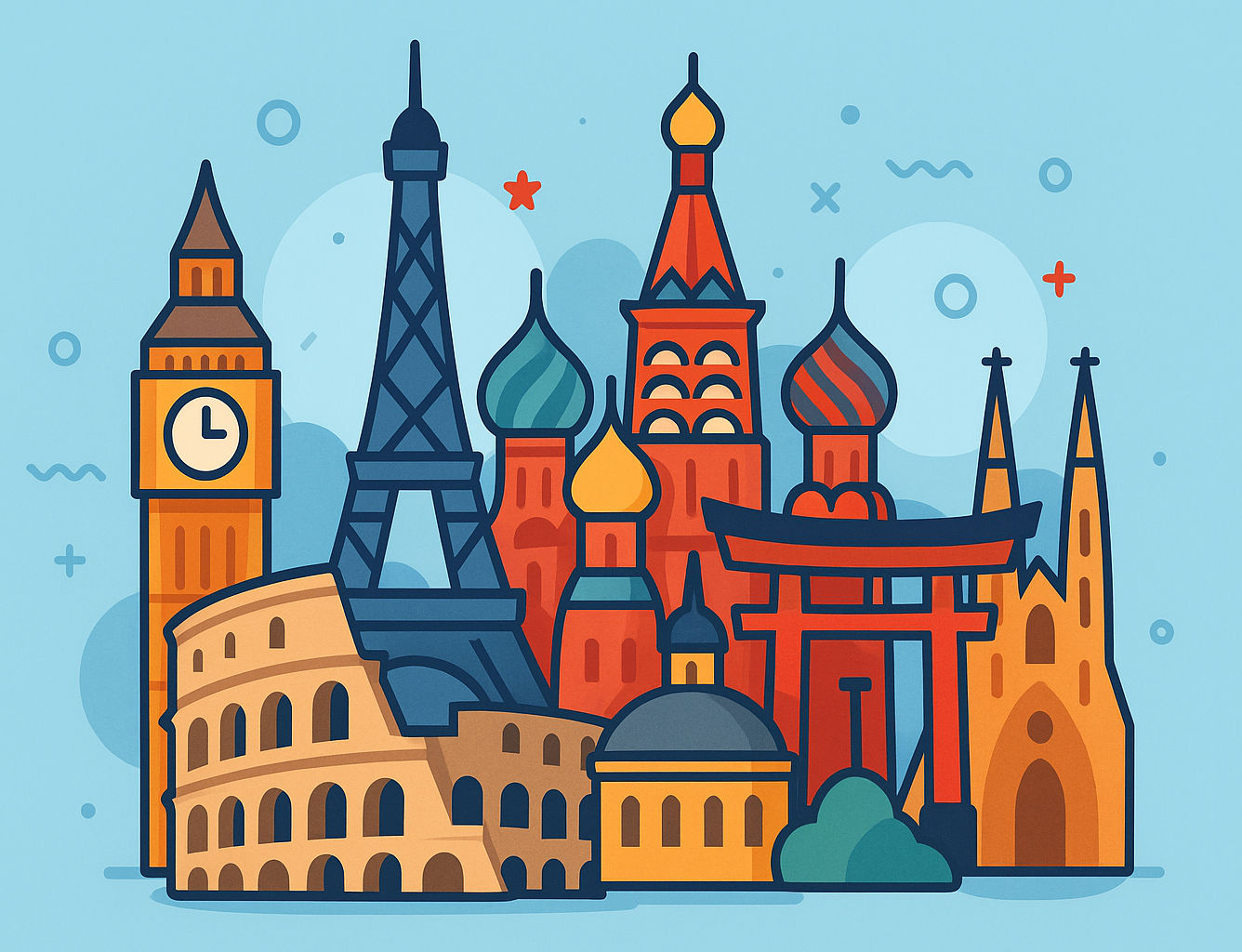Top 10 Cities with the Best Public Transport
June 20, 2025
In a world where urban mobility is becoming a cornerstone of both economic growth and environmental responsibility, having access to a reliable, efficient, and well-connected public transport system is more important than ever. For travelers, public transit isn’t just a convenience—it’s a gateway to exploring a city like a local. The best public transport systems in the world combine speed, safety, cleanliness, and comprehensive coverage to create a seamless experience for both residents and visitors.
From high-speed trains and metro networks to buses, trams, and ferries, these cities have invested heavily in infrastructure, innovation, and sustainability. They’ve designed their transportation systems to reduce traffic congestion, minimize carbon emissions, and improve quality of life. As a traveler, choosing a destination with outstanding public transport means saving time, money, and stress. You can navigate iconic neighborhoods, cultural landmarks, and scenic routes without the burden of renting a car or getting lost.
This guide highlights ten global cities that have earned a reputation for their top-tier public transportation networks. These destinations offer not just convenience but an immersive experience that reflects the rhythm of everyday life. Whether you’re on a subway under Tokyo, a tram through Zurich, or a double-decker bus in London, these systems represent the pinnacle of what modern, accessible, and smart mobility looks like.
10. New York City, USA

Despite its complexity and age, New York City maintains one of the most iconic and far-reaching public transportation systems in the world. Operated primarily by the MTA, the system includes subways, buses, ferries, and commuter trains that span the five boroughs and connect to surrounding regions. With 472 subway stations, NYC boasts the largest number of stations in any city globally.
The New York City Subway runs 24/7, a rarity among metro systems, allowing residents and visitors to move around the city at any hour. Trains and buses are integrated through the use of the MetroCard and the newer OMNY contactless payment system, making transit both convenient and cashless.
While the system may not be the newest, ongoing upgrades such as accessibility improvements, countdown clocks, and real-time mobile apps are modernizing the rider experience. The bus network covers even the most densely populated neighborhoods, and ferries offer scenic alternatives along the East and Hudson Rivers. For travelers looking to explore everything from Times Square to Brooklyn’s art scene without the need for a car, public transportation in New York City remains one of the most essential and immersive ways to see the Big Apple.
9. Vienna, Austria

Vienna excels in offering an elegant and well-organized public transport system that matches the city’s architectural grandeur and relaxed pace of life. The Wiener Linien operates five subway lines, numerous tram routes, and an expansive bus network that links every part of the city. Trains run every few minutes, and stations are accessible and adorned with clear signage.
The Vienna Card and weekly passes allow unlimited travel across the network. Stations are typically within a short walk of major sights such as Schönbrunn Palace, the Belvedere, and St. Stephen’s Cathedral. Trams in Vienna are a tourist attraction in themselves, offering scenic views as they glide past classical facades and tree-lined boulevards.
Vienna is also known for its environmental commitment. The public transport system relies on renewable energy and continues to expand in ways that prioritize both accessibility and sustainability. For travelers, Vienna’s public transport ensures that every journey is as refined and efficient as the city itself.
8. Berlin, Germany

Berlin’s public transport system, known as the BVG, integrates underground U-Bahn trains, overground S-Bahn trains, buses, and trams into a unified network that spans the entire city. The system operates with German precision, offering punctual, clean, and frequent services that make navigating the capital a breeze.
Whether you're commuting from Kreuzberg to Charlottenburg or heading out to Potsdam, connections are easy and travel times are short. Trains and trams run late into the night, and weekend night services operate throughout the night, making Berlin one of the most accessible cities for night owls and partygoers.
Tickets are valid across all modes of transport and can be purchased via apps or vending machines. The city emphasizes sustainability, multimodal travel, and digital convenience. With dedicated cycling lanes, park-and-ride stations, and free transit apps with real-time info, Berlin ensures that visitors can enjoy the city with minimal environmental impact and maximum mobility.
7. Hong Kong

Compact, vertical, and vibrant, Hong Kong boasts an extremely efficient and punctual public transportation system. The MTR (Mass Transit Railway) covers nearly the entire region, from the central business district to outer islands and residential suburbs. Trains arrive frequently, often every two minutes during peak times, and are known for their speed and reliability.
Hong Kong’s Octopus card is a benchmark in fare convenience, usable not only on public transport but also at restaurants, convenience stores, and attractions. The MTR system is enhanced by a vast network of double-decker buses, ferries, and trams, which provide stunning views of the city's skyline while keeping traffic congestion at bay.
Cleanliness and safety are top priorities. Stations are modern, wheelchair-accessible, and equipped with digital screens, shops, and customer service centers. The city’s public transit is designed to serve a high-density population without compromising comfort. Hong Kong’s transportation system is a shining model of what’s possible when infrastructure meets innovation in one of the world's most dynamic urban landscapes.
6. London, United Kingdom

Home to the iconic Tube, red double-decker buses, and sleek new Overground trains, London delivers one of the most iconic and efficient public transport experiences in the world. The Transport for London (TfL) network connects every corner of the sprawling metropolis, ensuring residents and visitors can travel with ease, even during peak hours.
The London Underground—known affectionately as the Tube—is fast, extensive, and supported by a real-time information system that keeps commuters updated at all times. The Oyster card and contactless payments simplify fare management and work across all modes of transport, including trams, river buses, and National Rail services.
Buses in London run 24/7, with clear digital displays and audible stop announcements, making navigation easy for all. Accessibility has improved significantly, with many stations offering step-free access and elevator services. Whether you're headed to Camden Market, the West End, or Heathrow Airport, public transport in London is reliable, intuitive, and deeply ingrained in the city’s culture.
5. Seoul, South Korea

Seoul combines innovation, cleanliness, and affordability in its world-class public transport network. The Seoul Metropolitan Subway includes over 20 lines that stretch far beyond city limits, linking urban centers with suburban areas. With bilingual signs, intuitive maps, and ultra-modern trains, Seoul's system is incredibly accommodating for international travelers.
Stations are immaculate and often double as cultural or shopping hubs, with art installations, underground malls, and themed décor. The trains are punctual, air-conditioned, and outfitted with digital displays indicating the next stop in multiple languages. Free Wi-Fi and charging ports are common, making commuting both convenient and comfortable.
What sets Seoul’s public transportation apart is its affordability and technological edge. Fare payment is easy using the T-money card, which works on subways, buses, and even taxis. In addition, buses are color-coded by route type and serve every neighborhood with clockwork precision. Seoul offers a glimpse into the future of smart urban mobility while maintaining a strong emphasis on user comfort and efficiency.
4. Paris, France

With over 300 metro stations and an expansive web of buses, trams, and suburban trains, Paris has one of the most comprehensive public transport systems in the world. Operated by RATP, the Paris Métro is legendary for its speed, efficiency, and accessibility to every corner of the city. Whether you’re visiting Montmartre, the Latin Quarter, or the Eiffel Tower, there’s always a station nearby.
The metro system’s art-nouveau station designs and compact layout make it uniquely Parisian. Most lines operate with short intervals, and real-time updates are displayed on digital boards throughout the network. The RER (Réseau Express Régional) trains extend coverage to the outskirts and nearby regions, making day trips to Versailles or Disneyland Paris easy and affordable.
Travelers can purchase navigo passes or multi-day visitor tickets for unlimited access across the network. Paris’s investment in tramways and bus rapid transit further supports sustainable movement throughout the city. Whether you're commuting during rush hour or navigating to a late-night café, public transportation in Paris offers unmatched efficiency and charm.
3. Singapore

Singapore’s public transport system is a textbook example of urban planning done right. The city-state has created a modern, efficient, and highly accessible network of MRT (Mass Rapid Transit) lines and buses that crisscross the island with incredible precision. Every station is clean, well-lit, and equipped with intuitive navigation tools, making it one of the most user-friendly public transport systems in Asia.
MRT trains run with high frequency and cover nearly every major neighborhood, business district, and tourist attraction. From Changi Airport to Marina Bay Sands, travelers can explore Singapore without ever needing a car. Each station is air-conditioned and includes elevators, escalators, and tactile flooring for the visually impaired.
Singapore’s buses are equally impressive, featuring GPS tracking, accessible entry points, and detailed real-time arrival info. Payment is easy with the EZ-Link card or contactless bank cards. The entire system is designed to encourage ridership while reducing congestion and emissions. Singapore’s commitment to sustainability, order, and innovation makes it a shining example of smart public transport infrastructure.
2. Zurich, Switzerland

When it comes to clean, punctual, and integrated public transport, Zurich sets a global standard. The city offers a smooth blend of trains, trams, buses, and even lake ferries—all under one coordinated network managed by the ZVV (Zürcher Verkehrsverbund). Whether you're traveling from the airport to downtown or navigating through residential districts, Zurich’s public transport is consistently fast, frequent, and exceptionally clean.
The trams in Zurich are iconic: sleek, blue, and gliding silently through streets that are free of traffic chaos. Most stops are well-equipped with real-time digital displays and offer barrier-free access. The Swiss commitment to efficiency is evident in the seamless transfers and perfectly timed connections. You can switch from a mountain cable car to a city tram within minutes and trust that both will be on schedule.
Tourists can take full advantage of Zurich’s well-connected system to visit landmarks like Bahnhofstrasse, Lake Zurich, and the Kunsthaus art museum without ever needing a taxi. The Swiss Travel Pass and Zurich Card offer unlimited access to public transportation and discounts on major attractions. For travelers seeking reliability and comfort, Zurich offers one of the best public transit experiences in Europe.
1. Tokyo, Japan

Tokyo boasts one of the most efficient, punctual, and expansive public transportation systems in the world. With over 13 subway lines, multiple train operators, and ultra-clean stations, Tokyo’s transit infrastructure is a marvel of organization and design. Despite its immense scale, the system is easy to navigate thanks to color-coded maps, multilingual signage, and clear announcements.
The trains in Tokyo are known for their exact departure times—often down to the second. During peak hours, platform attendants assist passengers to ensure smooth boarding. The system connects seamlessly across the Greater Tokyo Area, meaning travelers can move from the heart of Shibuya to the quiet streets of Kamakura with minimal effort. Even the most remote suburbs are serviced by clean, reliable trains.
Travelers will find that Tokyo’s public transport is not only dependable but also incredibly safe and secure. Stations are equipped with amenities like lockers, vending machines, and public restrooms, all of which are maintained to high standards. A reloadable IC card such as Suica or Pasmo makes fare payment fast and contactless. If you want to experience Tokyo like a local, there's no better way than immersing yourself in its high-tech, high-functioning transit world.
Final Thoughts
As cities around the globe face the pressures of urbanization, climate change, and evolving travel needs, the importance of reliable, eco-friendly public transportation cannot be overstated. The cities featured in this guide stand out not just for their infrastructure, but for their commitment to making transit an integral part of daily life—accessible, affordable, and environmentally responsible.
Traveling through a city by bus, metro, or tram isn’t just about getting from point A to B. It’s about participating in the life of the city, observing local rhythms, and reducing your carbon footprint. From Tokyo’s lightning-fast trains to Vienna’s graceful trams and Singapore’s spotless MRT lines, each system tells a story of thoughtful planning and community trust.
Choosing a destination with outstanding transit options means more than convenience—it offers freedom, discovery, and peace of mind. For travelers, that translates to less time worrying about logistics and more time enjoying the experience. So as you plan your next adventure, consider visiting one of the top cities with the best public transport systems. You’ll see the world not only more easily, but more responsibly—and that’s the future of travel.


